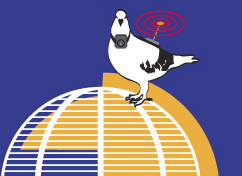absence, community, networks, memorials, communication, space, place Expanding on Jean-Luc Nancy's theory of the Inoperative Community, this paper will draw from recent memorial practices and communication theory to argue for the importance of absence in the construction of sound networks. Blindly celebrated by dystopian modernists, and blissfully ignored by utopian technophiles, the experience of absence is crucial to a nonviolent and just approach to communion.
Abstract "The fully realized person of individualistic or communistic humanism is the dead person."
-Jean-Luc Nancy Throughout modernity, imagined communities of fused individuals have been followed or even predicated by hoped-for networks of fused places. In these utopian spaces, presence is the goal, and absence an obstacle. Yet in recent theories of communication, political thought, and analyses of memorial space, acknowledgment of absence and loss has emerged as not only desirable, but perhaps crucial to functional society. How and why might we build more recognition of absence into our networks? Drawing from examples in theory and practice, this paper will construct a "homology" of absence, borrowing from Bourdieu's use of this biological term to describe structurally similar, if irreducible, power structures across different fields of production. For the role of absence in memorial space, I'll draw from the work of Andreas Huyssen, and his examination of counter-monuments, transitional monuments, or disappearing monuments. He examines why we might cautiously approach the preservation of traumatic voids as a desirable answer to the need for memorials. For the role of absence in political thought, I'll rely on Jean Luc Nancy's notion of the "inoperative community" in which dreams of fusion or immanence are abandoned in favor of a new definition of personhood as "singular." Here, recognition of the limits of self constitutes both being and community. Finitude does not necessitate autonomy. I'll also look at recent work in the history of technology and communication (Sconce, Schmidt, Peters) that shows how new instruments of telecommunication rushed to fill the spiritual void left by the Enlightenment, creating mythologies of presence that set us up for new failed connections to the divine. From an understanding of the promises and perils of acknowledging absence, I'll then apply this homology of absence toward an examination of recent experiments in telepresence. Examples will include: /Isophone/, by Auger, Loizeau, and Agamanolis of MIT Elliott Malkin's work with "tele-absence" /INNetwork/, by Mandlberg and Steinmetz /Transitions/ , Ulrika Wachtmeister's winning entry for Holland's Fusedspace competition The fabled "Mojave Phone Booth" Lastly, some concluding cautions and hopes: If we define absence as an everyday and constant condition, we do risk trivializing absence that is the result of real loss. (LaCapra) If we fail to identify the role of embodied experience of space in the perception of absence, we risk even more an abstracted and romanticized view. By pairing a discussion of public space with an examination of networked space, we invite a deeper analysis of the politics of interaction in a field all too-often understand as spatially neutral. Kevin Hamilton Kevin Hamilton is a researcher and instructor at the University of Illinois, Urbana-Champaign. His work and teaching examines topics such as walking as an embodied critical practice, collaboration and remix culture, and the political uses of liveness and telepresence. His recent exhibitions, public projects, and festival presentations include the Dutch Electronic Arts Festival, New Forms Festival(BC), Mad'03(SP), CiberArt Bilbao, Multiplace(SK), and the Indianapolis Museum of Contemporary Art. Online recognition has included features by Chicago's Bodybuilder and Sportsman Gallery, V_2's Fusedspace competition, and the Artbase at Rhizome.org. In 2005, Kevin co-organized WALKING AS KNOWING AS MAKING, an experimental and international symposium series at UIUC; he also curates for a new media exhibition and commission program at the Siebel Center for Computer Science in Urbana, IL. With a background in painting at the Rhode Island School of Design, Hamilton completed his graduate studies at MIT's Visual Arts Program in 2000. URLS:
http://www.kevinhamilton.org http://www.turbulence.org/Works/innetwork/ http://www.dziga.com/tele-absence/ |
